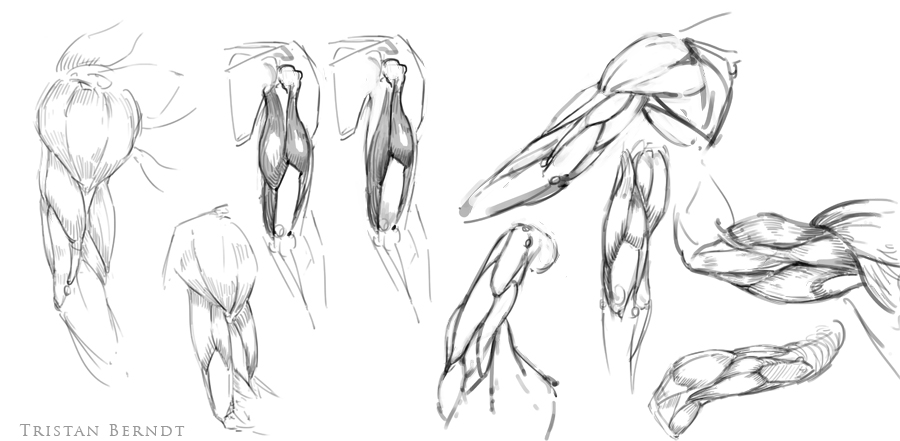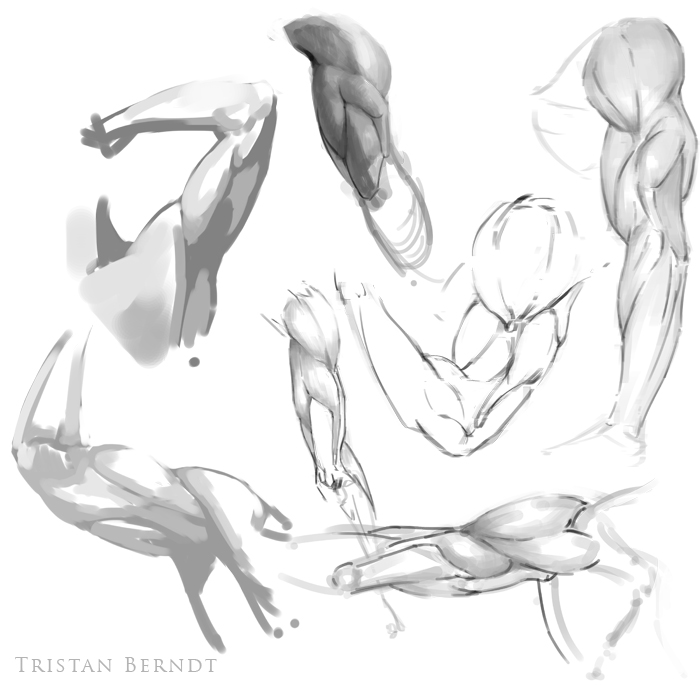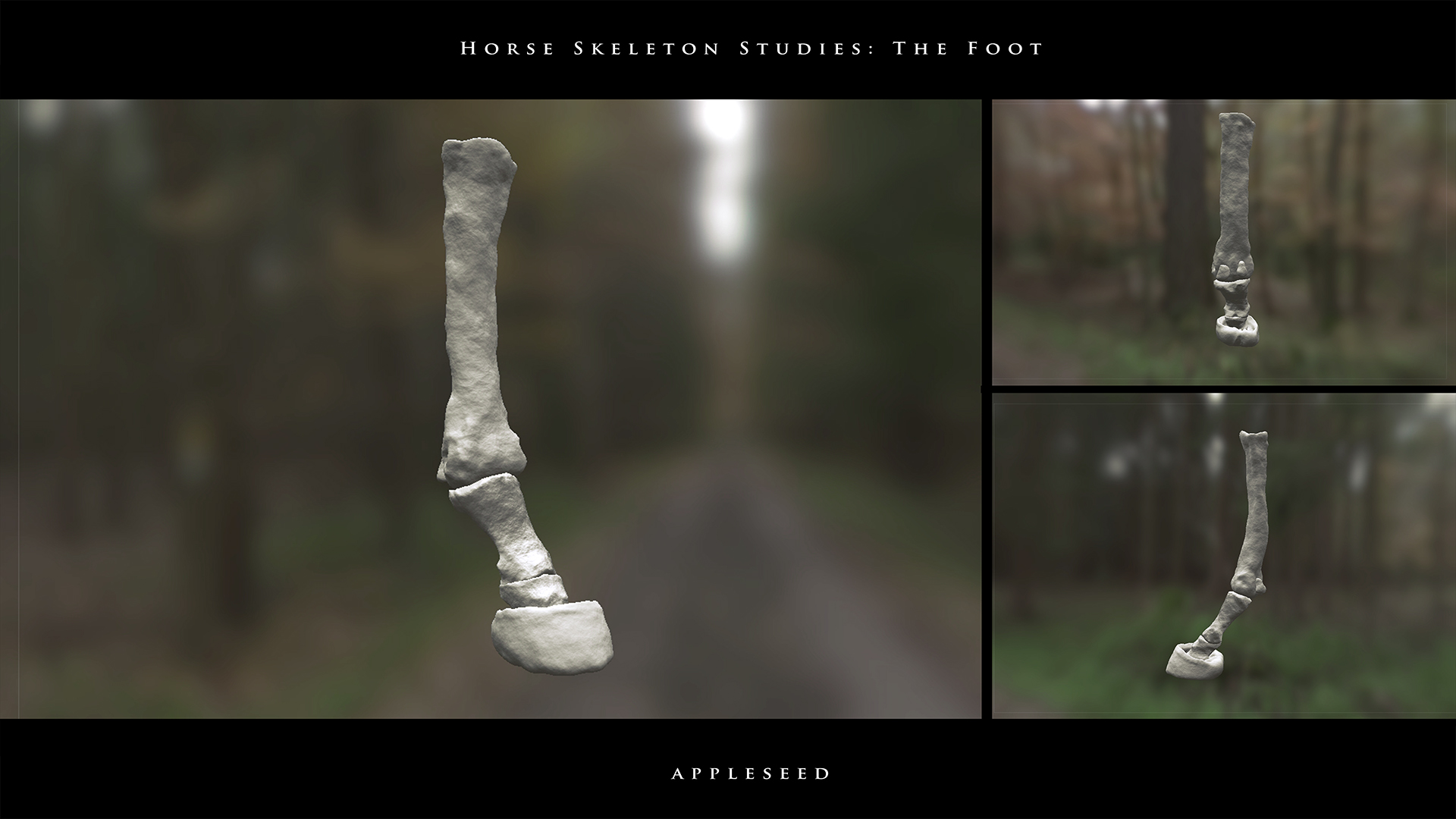07-22-2015, 04:15 AM
Tricep studies


Discord - JetJaguar#8954
|
THE CRIMSON CADAVERS
|
|
07-22-2015, 07:50 AM
Damn Tristan, that is awesome! I will go back and have a look at the points you mentioned. Your last full figures are sweet! Are you using photos or is this from memory? Impressive either way. Honestly the only thing I can spot is a general placement issue of the entire right leg in the bottom right drawing. Something about it seems disconnected slightly from the torso in the twist. VERY nitpicky though.
07-22-2015, 03:28 PM
Hey sorry my last figures werent that anatomical. Part of it was because the model was a bit thick. With this weeks model I was able to emphasize land marks more though Im still not sure if this is anatomical enough to be appropriate for here. Its another 20,40 and 20 minute pose set. At least I didnt post the 5 and 1 minute poses :P As always I appreciate anyones feed back on placement or whatever you think is wrong. Be as nit picky as you like.
07-23-2015, 01:58 AM
Amit - Thanks man. Yeah, those where based on photos. You're right about the leg looking a bit detached. I should probably try and figure out a way to merge the figure rather than having it look like a frankenstein body with parts that individually look okay but together look uncanny.
Adam - Hey, man. Those figure look good but you're still not studying anatomy. The first image you posted was closer but some landmarks aren't clearly marked or even ignored (There's a document in the resource section that shows all landmarks). This group is for people to study human anatomy and what is beneath the skin. This requires you to study from anatomical plates/books and then when drawing the figure, deducing what is beneath the skin rather than just drawing the model with skin and fat. Figure drawing is all fine and dandy but this group is for the dirty work behind learning how to draw the figure. I'd like to keep this group focused on this because it is largely ignored by artists all over the place. If we're lucky, this group could help mitigate this but that means being a bit of a hardass when it comes to what goes on in the group. I don't like calling people out but you have to study anatomy to post in the group. We have a resource section with books and reference that should help you out. Some more Tricep studies. I'm now going to move on to the forearm. 
Discord - JetJaguar#8954
07-23-2015, 02:34 AM
Oh sorry again haha! I just misunderstood you that you only want muscles and bone drawings. I tried to follow what you said before about showing landmarks with that top drawing. I just realized the head of the fibula is missing. I have little circles to show the trochanters but it might be hard to see in the photo. I always forget about the pubic symphysis too. Thanks!
Oh and I'd recommend focusing on always starting with a gesture to avoid the disjointed problem you mentioned. I use the Reilly figure system mostly. Jeff Watts has an even more anatomically refined version of the Reilly method I'd bet you would really like. Heres a video of him demoing it for 3 hours. https://www.youtube.com/watch?v=zKfsZaNrmzM if you skip to 2 hours 53 minute in mark he shows his much more complex version of the abstraction that uses a lot more anatomical indications. I couldnt find any images of it on google images but you can get a good look at it from the video and watching his quick sketches will show you how hes using it to easily get a nice congruent basic gesture with a lot of anatomical information.
07-23-2015, 05:03 AM
(07-23-2015, 02:34 AM)Adam Lina Wrote: Oh sorry again haha! I just misunderstood you that you only want muscles and bone drawings. I tried to follow what you said before about showing landmarks with that top drawing. I just realized the head of the fibula is missing. I have little circles to show the trochanters but it might be hard to see in the photo. I always forget about the pubic symphysis too. Thanks! rallies stuff
07-23-2015, 05:26 AM
Adam - I'm not sure how well you know your landmarks. You didn't even mark the sternum... Not trying to be a dick but look at our resource section. There is a document that shows all the skeletal landmarks. Don't rely on what you "know" because doing so means you are preventing yourself from learning what you do not know.
I'd strongly advice any student to avoid any gesture or quick block in when seriously drawing the figure. In the words of Solomon J. Solomon "I thoroughly disapprove of what is understood by the "blocking in" of the whole figure or object that is commonly practiced. The followers of this method begin by putting a series of hurried lines on the paper, with the object of seizing the pose and suggesting the proportions of the model. Nothing could be more unsound, especially in the case of the beginner. The moral influence of our first stated impressions, hurried and ill-considered as they thus must be, is so great that we never entirely free ourselves from it, and the student who begins his work without due deliberation spends most of his time at the subsequent sittings in correcting the faults of his first hurried sketch." Gesture drawings should be just that, gesture drawings. When trying to learn something, starting vague just means that you need to be correcting your mistakes while at the same time trying to learn other things. If you can create an accurate outline drawing using the sight size method, studying anatomy after that point becomes much easier. Watts atelier is one of the fringe atelier when it comes to "academic art". They do not appear to follow either the French or Russian academic process that most ateliers use and I think it's important to take what they say with a bit of salt. The Reilly method is fine to learn but it should be used when it is useful. It should never dictate your drawing and this is something I see happening all the time. This isn't all that relevant to anatomy so I'd prefer to keep it out of the group. The subject of figure drawing goes into your sketchbook. If you want to do écorché drawings, you're welcome to post them here but I do not want to see construction drawings, gesture drawings or figure drawings. This is a place for anatomy.
Discord - JetJaguar#8954
07-23-2015, 07:19 AM
Adam, nice figures, really tough pose on that last one!
I think a great study to do, would be to take one or two of your life drawings, and do an ecorche of the same pose. I realised recently how amazingly little i know about the musculature even though my figures can turn out fine. After studying the musculature in a pose, I am starting to be able to visualise it underneath, and it makes my drawing process so much more confident. It really is worth doing! I can't say anything about different processes at ateliers, but I have a general philosophy that there is no absolute right way to do anything in life. There are only opinions, and i can't I have one in that debate as I know nothing. Tristan does have a point that is interesting that I can see that gestures might take away from proportional accuracy and landmarks especially for beginners, but I can see how they would be useful to nail a pose for imaginative work or if you are short on time and already have a good handle on proportion and anatomy. Tristan. I find twisting torso poses obscuring connection points on limbs very easy to screw up. Anyway I should refrain from posting unless I have some images to post as well. :)
07-23-2015, 07:55 AM
Amit - You're right in that there is no "optimal" way and I may have overstated harm of gesture drawing in an absolutist way (I do sound dick-ish sometimes). If you apply certain principals from gesture drawing (weight, counter rhythms and so on) you can arrive at a very good anatomical drawing.
So without backtracking completely I'd say that in the process of studying anatomy, things like proportions become very important. Proportions are the initial frame where all muscles and bones fit and if the proportions/drawing is off, you are forced to warp muscles to fit the drawing. Bringing in gesture drawings as a foundation for these kinds of studies (like Solomon wrote) forces you to keep correcting your initial drawing as you try to work. That's one reason I really prefer the academic approach of contour drawing and then applying any rhythmic construction only when appropriate rather than itself being the foundation.I find them useful as things to memorise to then better orient myself, not necessarily used in the actual drawing. Also to make it clear for anyone reading this in the future. I'm not saying Watts is bad, just different. I'd still recommend them if you have the cash.
Discord - JetJaguar#8954
07-23-2015, 08:05 AM
Thanks for the landmarks document, that is really helpful!
I tried again with a more detailed skeleton... ![[Image: eBXo2YZ.jpg]](http://i.imgur.com/eBXo2YZ.jpg)
07-23-2015, 08:13 AM
Well thats fine I respect your preference to not have figure drawings in the group. Im a lover of anatomy as well and in a few months time I plan on getting deep back into it. I am aware of the sternum by the way. I thought it was evident where I've indicated its placement with the position of the breasts, the line I used to show the bottom edge of the rib cage and the pit of the neck that more or less form its boundaries.
To give you more of a frame of reference of what my current understanding of anatomy is. I've read and copied these books on figures and anatomy. Figure Drawing for all its worth, Figure Drawing: Design and Invention, Anatomy for the Artist and I've studied some of Bridgman's books and Elliot Goldfinger's. I not only copied the drawings. I took notes on the origins and functions of muscles and committed it to memory. Plus I've studied most of Proko's older videos before his current anatomy series came out. Now Im not trying to say Im an expert of anatomy but Im no slouch and I definitely know the landmarks. Not that Im mad at you or am trying to defend my ego, just trying to establish mutual understanding of where Im coming from. Im aware of the different camps of sight size vs comparative measurement. I wont try and convince of its merits. I'll only say that I see both sides and dont identify myself with either. Amit, thanks man! I will eventually give that a try I promise you :) Right now my time is divided up with many things and I need to choose my battles. I hope to contribute to the group in the future because anatomy is probably my biggest interest in art.
07-23-2015, 08:38 AM
Ok this is my last comment with no image attached.
@Tristan don't worry about sounding like a dick. Sometimes honesty is perceived as dickish I know as I do this myself (Although I realise I am actually a dick at times. Sigh) I still prefer the tell it straight approach. Nice to hear you aren't some militant fundamental euro atelierist. :P @Adam, yeah man I can tell you have studied anatomy pretty well from your figures, it does show. Always room for more depths to dive! :) @Olooriel. I think that is fantastic. Taking feedback like a boss!
07-23-2015, 11:00 AM
This isn't my own work, but this is how it's done. Damn. Love that they used a sculpture too.
![[Image: 00a15f4e62f696fa910bb62b0e2b800c.jpg]](https://s-media-cache-ak0.pinimg.com/736x/00/a1/5f/00a15f4e62f696fa910bb62b0e2b800c.jpg) ![[Image: 7a042acff2f34b1039937f661b943de7.jpg]](https://s-media-cache-ak0.pinimg.com/736x/7a/04/2a/7a042acff2f34b1039937f661b943de7.jpg)
07-24-2015, 02:45 AM
Wow , Crimson Cadavers has been kicking to full gear the last time i was here. i really liked the back and forth discussion thats going on and im learning alot from all the peeps whos posting here. i really do.
Just to add to the Drawing methods topic, i do find the advantages of both, Comparative and sight size. doing them back and forth , wich is what im trying to do now, can tell how much you need to work on one method to the other. for example, i have worked on Comparative method for quite some time now, for me it felt very natural , although i think i haven't been able to master it yet. its really useful in a pinch, but could take extra effort on being accurate because you need to convert the measurement of what you see to what you have "commited to " in the beginning now when i get to Sight size , it feels very foreign , though it might seem that the two methods would complement each other, im still picking up , or "SEEING" things with my eyes that i wasn't able to see with comparative. so yeah what im trying to say here , if you want to be a master in drawing , practice a great deal with the two. its going to be hard, especially when youre alone. ok pretty much said what i wanted to say, but theres this awesome book called anatomy for sculptors. more info in here https://www.anatomy4sculptors.com/anatomy.php the site has chock full of resources as well. gonna do some ecorche later on. im just doing some bargue studies right now to improve my lines. like what @tristan said, im doing them digitally , so its kinda hard to draw my lines. but what the heck im training my eye.
07-24-2015, 04:42 AM
Olooriel - I really didn't expect that... Damn, you tackled that critique head on! That's really a lot better relative to your last post. Some further minor critiques is that the femurs are a little wide and bulky at the knees. The iliac (hip bones) is somewhat crunched. It's one of the harder areas of the figure and fairly difficult to get right. If you look at some reference and try to do a few more, just focusing on that area I think you'll get it right! You might also like to draw the hipbones separately a few times to get familiar with their complicated shape.
Adam - Hey, looking back I was a dick and an apology is in order. I'm sorry for being a jerk. I got a bit annoyed as "my" anatomy thread was getting a bunch of figure drawing in it after I felt that I addressed it. Still, I hope I see you post more in the group :) Amit - I learned a ton from tracing over classical sculpture, finding all the landmarks and drawing the anatomy. It's really fun and difficult. Classical sculpture had a very high standard when it came to figurative art so you would rarely find a mistake in their anatomy ^^ Also, "militant fundamental euro atelierist", I try not to be ;) I do however have a tendency (like most) to forget to include more nuance in advice and critiques. It's a flaw in character that I need to work on. Kurt - I'm putting this under a spoiler so we don't fill an entire thread with a discussion about drawing in an anatomy thread ;) I'm looking forward to seeing you post some of your work! :)
Discord - JetJaguar#8954
07-24-2015, 11:20 PM
Tristan, no apology needed. I can be pretty annoying at times haha!
Olooriel, I was trying to do a quick draw over to point a few things out I noticed but my photoshop is not liking my yiynova at the moment. So the best I can do is try to explain it. Tristans advice was dead on. Also if you look at the ladies bent knee you can see the faint form shadow of her knee cap. You've place the knee cap a bit above where it actually rests. You are confusing the knee cap for the tibial tuberosity. The patella (knee cap) actually glides up and down over the knee joint as the leg bends. I think this video will really help you see the knee for what it is https://www.youtube.com/watch?v=_q-Jxj5sT0g Also this one will help you with the arm issues https://www.youtube.com/watch?v=3l3-5Ij3JZ8 I see issues with you understanding of the pelvis as well. You're not placing the iliac crest correctly which is the one of the biggest keys to understanding whats going on under the surface. The over all form of the pelvis is off as well. I recommend Prokos new videos on anatomy. Go through individual parts instead of trying to tackle the whole skeleton at once. His Skely app is also really great and totally worth the 7 USD.
07-25-2015, 10:25 AM
I finally manage to contribute. Hope sculpts are ok
Horse studies: The foot. Missed out the non visible bones. was fun to do  Programs Used: 3D Coat Photoshop
07-26-2015, 04:49 AM
Bit late to the party, but better late than never, right? :)
First time doing an ecorche. ![[Image: tumblr_ns23swwFKn1rzshiso1_1280.jpg]](https://41.media.tumblr.com/3a22354fa0b6d21fd091be53d6ba3a5f/tumblr_ns23swwFKn1rzshiso1_1280.jpg)
07-26-2015, 09:36 PM
|
|
« Next Oldest | Next Newest »
|